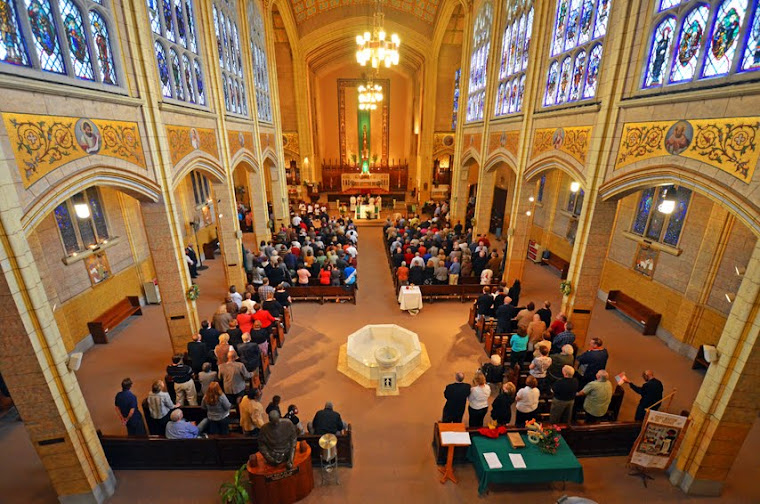Austin church blends old and new, black and white
En route to St. Thomas Aquinas church in South Austin, the cab driver turned east on Washington Blvd. at Central Av.
On the southeast corner of the intersection there stood one of the signs of former times -- a graceful home bearing the unmistakable signature of Frank Lloyd Wright.
As the car headed east, signs of the present came into view -- some refurbished old buildings, a few abandoned buildings. On a light pole, a leftover campaign poster proclaimed "Carey fights crime, not people."
Then, there was the church. Italian Gothic a la Chicago, 1923. Soaring steeple. Prominent cross. Splendid stained-glass windows. Formidable rectory. Parochial school with cutouts of the pilgrim fathers pasted on the windows. On the doors, invitations to "Play Bingo Monday Night. One jackpot game!"
The church doors were locked: "If you wish to visit the church, ring the bell at the rectory." Outside the rectory door, there was a telephone: "If the phone rings, please answer it."
The phone didn't ring but the door was opened anyway by the pleasant housekeeper who welcomed a visitor as she finished the last bites of her lunch.
The reception room inside looked like dozens of other rectory reception rooms -- the inevitable desk, red carpet, leatherette armchair, and two or three wooden chairs from somebody's old dining-room set. From his place inside a picture frame, a smiling Pope John XXIII looked down, appearing to give his blessing.
"Father," the visitor said, as the Rev. Charles Tobin walked into the room, "there's been a change of Popes. Haven't you heard?"
"Well, I guess some of the Popes are more popular than others," the young priest replied.
Soon the two who were gathered together were joined by a third, the Rev. Edward McKenna, another member of the parish's three-man team of ministers. The third team member, the Rev. John McCarville, was out of town.
"This parish was organized before World War I," Father McKenna said. "Most of the people were Irish or Italian. The building was put up in 1923.
"At its peak -- that was in the 1940s and 50s -- the church served somewhere between 2,000 and 3,000 families. In those days, I understand, the ushers wore pinstrip pants, tails and boutonnieres.
"Now, we have 300 or 400 families on our register. Nearly all the people are black, although a few elderly whites still live here. And then there's a sprinkling of Spanish people. We have a Spanish mass at 9:30 a.m. every Sunday."
Zestfully, the priestly teamsters described their efforts to fashion a parish that is truly "catholic" in the dictionary sense of that term: "Affecting people generally ... Inclusive in human affairs ... comprehensive or very broad in sympathies, understanding, appreciation or interests ... not narrow, isolative, provincial or partisan."
About the only word in that definition the priests would not buy is the word "partisan." They claim they are partisans for the poor, the oppressed, the victims of injustice.
Father Tobin has been treasurer of the Organization for a Better Austin, the militant community organization which has attempted to insure that Austin residents will have a voice in determining the destiny of their area. Father McKenna, who recently came within 19 votes of being elected president of the OBA, has been chairman of the organization's housing committee which has waged a long-term fight against slumlordism and panic-peddling.
Housed in the church building is the so-called base station of "Soul Patrol." Operating under OBA auspices, Soul Patrol is a two-way radio network which enables neighborhood residents to get in touch quickly with police when they become aware that a crime has occurred or is about to occur.
Unlike some social activists, the priests at St. Aquinas take seriously the liturgical and theological traditions of the church. As a matter of fact, their catholicity is so broad that they are willing to concede there is a place in the life of a reform-minded parish for some of the non-elitist customs of conventional Catholicism -- bingo, for example, and a "giant five-car raffle" and a fashion show.
"We have a retired priest who comes here, an old monsignor," Father McKenna said. "he attends and sends us money because, in our attempts at reform and ecclesiastical house-cleaning, we haven't thrown out everything.
"I have the feeling that some reformers have engaged in a lot of trashing -- that is, wholesale abandonment of tradition.
"No one would ever think of Saul Alinsky (the radical reformer) as a liturgical guide, but I do. I vividly remember a speech in which Alinsky hammered away at the idea, 'Know your history. Then you'll understand where you're at."
With this not-so novel idea in mind, the St. Aquinas team weaves into its liturgical services threads drawn from many centuries.
On Pentecost Sunday last May, for example, the liturgy for confirmation included a Gregorian chant as well as music by such contemporary composers as Flor Peters, Randall Thompson and the black priest, the Rev. Clarence J. Rivers.
In October, a "Mass of the Blessed Virgin Mary" included a hymn from the 16th Century Genevan Psalter and a Latin musical setting for the mass written by Palestrina.
At 3 p.m. on Nov. 25 a solemn requiem mass for "all the faithful departed of our parish and for our beloved Catholic President, John Fitzgerald Kennedy," will be offered with most of the polyphonic music coming from the work of a Renaissance priest, Tomas Luis da Victoria.
By blending the old and the new, the black and the white, the church in the street and the church in the sanctuary, the St. Aquinas team hopes it is being faithful to "the God who was and is and is to be" and hopes it will be successful in creating a Catholic parish that is catholic in every sense of that term.
Chicago Sun Times, November 18, 1971.

No comments:
Post a Comment